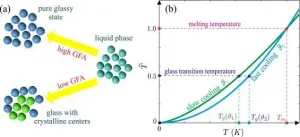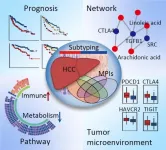Remarkable new insights into the pathology of Usher syndrome
Usher syndrome 1G protein SANS regulates the splicing of genes, particularly those linked to Usher syndrome
2021-07-12
(Press-News.org) Human Usher syndrome (USH) is the most common form of hereditary deaf-blindness. Sufferers can be deaf from birth, suffer from balance disorders, and eventually lose their eyesight as the disease progresses. For some 25 years now, the research group led by Professor Uwe Wolfrum of the Institute of Molecular Physiology at Johannes Gutenberg University Mainz (JGU) has been conducting research into Usher syndrome. Working in cooperation with the group headed up by Professor Reinhard Lührmann at the Max Planck Institute for Biophysical Chemistry in Göttingen, his team has now identified a novel pathomechanism leading to Usher syndrome. They have discovered that the Usher syndrome type 1G protein SANS plays a crucial role in regulating splicing process. Furthermore, the researchers have been able to demonstrate that defects in the SANS protein can lead to errors in the splicing of genes related to the Usher syndrome, which may provoke the disease.
Further research on how the SANS protein contributes to the development of blindness needed
"We are aiming to elucidate the molecular basis that leads to the degeneration of the light-sensitive photoreceptor cells in the eye in cases of Usher syndrome," said Professor Uwe Wolfrum. For sufferers with USH, cochlea implants can be used to compensate for hearing loss. However, there are currently no existing treatments for the associated blindness. The current investigation is focusing on one of the Usher syndrome proteins, the USH1G protein, known as SANS. Previous research undertaken by Wolfrum's team established that SANS acts as a scaffold protein. SANS has multiple domains to which other proteins can dock, thus ensuring correct cellular function. Mutations in the USH1G/SANS gene lead to malfunctions of the auditory and vestibular hair cells in the inner ear and of the photoreceptor cells of the retina, which are responsible for the sensory defects experienced by Usher syndrome patients.
It remains unclear how SANS contributes to pathogenic processes in the eye. Encoded by the USH1G gene, the protein is expressed in the photoreceptors of the retina and glia cells. "So far, we had thought of SANS simply as a scaffold molecule that participates in transport processes in the cytoplasm associated with ciliary extensions," said Wolfrum. "But recently, Adem Yildirim in his PhD thesis conducted in the International PhD Program (IPP) in Mainz discovered that SANS interacts with splicing factors to regulate pre-mRNA splicing."
SANS regulates the splicing of pre-mRNA
Splicing is an important process in path from the coding gene to the biosynthesis of proteins. What happens during splicing is that non-coding introns are removed from initially transcribed pre-mRNA or, in the case of alternative splicing, exons that are not required for the subsequent protein variant are excluded. The resulting mRNA is then used for protein biosynthesis. The splicing process is catalyzed in the nucleus by the spliceosome, a dynamic, highly complex molecular machine that is successively assembled during the splicing process from a number of subcomplexes of protein and RNA components.
"We were surprised by our finding that SANS is not only a component of the transport to cilia at the surface of the cell but also active in the nucleus and can modulate the splicing process there too", said Wolfrum, referring to their results published in Nucleic Acids Research. In the cell nucleus, SANS is responsible for transferring tri-snRNP complexes, or components of spliceosome subcomplexes, from the Cajal bodies, a kind of molecular assembly line, to the so-called nuclear speckles. In this compartment, tri-snRNP complexes bind to the spliceosome assembly to subsequently activate it. SANS is also likely to be involved in recycling the tri-snRNP components back to the Cajal bodies.
The absence of SANS and also pathogenic mutations of the USH1G/SANS gene prevent the spliceosome being correctly assembled and sequentially activated. This, in turn, suppresses the correct splicing of other Usher syndrome-related genes, ultimately leading to their dysfunction and therefore to the development of the disorder. "Thus, we provide the first evidence that splicing dysregulation may participate in the pathophysiology of Usher syndrome," is how the authors sum up their results in their article. And Professor Uwe Wolfrum added: "In addition to the new findings relating to the splicing mechanism, we have also identified new aspects that we aim to investigate with regard to developing concepts for the treatment and therapy of the Usher syndrome in future."
INFORMATION:
Related links:
https://www.ag-wolfrum.bio.uni-mainz.de/ - Wolfrum lab at the JGU Institute of Molecular Physiology (IMP);
https://www.blogs.uni-mainz.de/fb10-biologie-eng/about-the-faculty-of-biology/institutes/institute-of-molecular-physiology-imp/ - JGU Institute of Molecular Physiology (IMP)
Read more:
https://www.uni-mainz.de/presse/16842_ENG_HTML.php - press release "European young investigators network for Usher syndrome awarded an E-Rare collaborative research project for young scientists" (13 Nov. 2013) ;
https://www.uni-mainz.de/presse/15924_ENG_HTML.php - press release "Ray of hope for human Usher syndrome patients" (4 Dec. 2012) ;
https://www.uni-mainz.de/presse/14329_ENG_HTML.php - press release "Treatment approach to human Usher syndrome: Small molecules ignore stop signals" (1 July 2011)
[Attachments] See images for this press release:

ELSE PRESS RELEASES FROM THIS DATE:
2021-07-12
Turning away from fossil fuels is necessary if we are to avert an environmental crisis due to global warming. Both industry and academia have been focusing heavily on hydrogen as a feasible clean alternative. Hydrogen is practically inexhaustible and when used to generate energy, only produces water vapor. However, to realize a truly eco-friendly hydrogen society, we need to be able to mass-produce hydrogen cleanly in the first place.
One way to do that is by splitting water via "artificial photosynthesis," a process in which materials called "photocatalysts" leverage solar energy to produce oxygen and hydrogen from water. However, the available photocatalysts are not yet where they need to be to make solar-powered water splitting economically feasible and scalable. ...
2021-07-12
Co-authors Bulat Galimzyanov and Anatolii Mokshin (Department of Computational Physics) have developed a unique model that allows for a universal interpretation of experimental data on viscosity for systems of different types, while also proposing an alternative method for classifying materials based on a unified temperature scale.
The publication was funded by Russian Science Foundation's grant 'Theoretical, simulation and experimental studies of physical and mechanical features of amorphous systems with inhomogeneous local viscoelastic properties', guided by Professor Mokshin.
Using the developed viscosity model, scientists processed experimental data obtained for thirty different ...
2021-07-12
A research group led by Prof. PIAO Hailong from the Dalian Institute of Chemical Physics (DICP) of the Chinese Academy of Sciences (CAS) identified hepatocellular carcinoma (HCC) subtypes with distinctive metabolic phenotypes through bioinformatics and machine learning methods, and elucidated the potential mechanisms based on a metabolite-protein interaction network and multi-omics data.
The study, published in Advanced Science on July 11, provides insights guiding precise personalized HCC medicine.
Metabolic reprogramming, which can promote rapid cell proliferation by regulating energy and nutrient metabolism, is considered to be one hallmark of cancer. It can impact other biological processes through complex metabolite-protein ...
2021-07-12
The ubiquitous overuse injuries that nag runners may stem from an unlikely culprit: how far you lean forward.
Trunk flexion, the angle at which a runner bends forward from the hip, can range wildly--runners have self-reported angles of approximately -2 degrees to upward of 25. A new study from the END ...
2021-07-12
DALLAS, July 12, 2021 -- People of South Asian ancestry have more than double the risk of developing heart disease compared to people of European ancestry, yet clinical risk assessment calculators used to guide decisions about preventing or treating heart disease may fail to account for the increased risk, according to new research published today in the American Heart Association's flagship journal Circulation.
About a quarter of the world's population (1.8 billion people) are of South Asian descent, and prior research has shown South Asians experience higher rates of heart disease compared to people of most other ethnicities.
To better understand the variables surrounding the heart disease risk for people of South Asian ancestry, researchers evaluated ...
2021-07-12
A novel method of gene therapy is helping children born with a rare genetic disorder called AADC deficiency that causes severe physical and developmental disabilities. The study, led by researchers at The Ohio State University Wexner Medical Center and The Ohio State University College of Medicine, offers new hope to those living with incurable genetic and neurodegenerative diseases.
Research findings are published online in the journal Nature Communications.
This study describes the findings from the targeted delivery of gene therapy to midbrain to treat a rare ...
2021-07-12
USC researchers have achieved a better way to identify elusive DNA variants responsible for genetic changes affecting cell functions and diseases.
Using computational biology tools, scientists at the university's Dornsife College of Letters, Arts and Sciences studied "variable-number tandem repeats" (VNTR) in DNA. VNTRs are stretches of DNA made of a short pattern of nucleotides repeated over and over, like a plaid pattern shirt. Though they comprise but 3% of the human genome, the repetitive DNA governs how some genes are encoded and levels of proteins are produced in a cell, and account for most of the structural variation.
Current methods do not accurately detect the variations in genes in some repetitive ...
2021-07-12
Scientists have produced the first fine-detail molecular blueprints of a bacterial enzyme known as Lit, which is suspected to play a "stealthy" role in the progression of infection by reducing the immune response.
Blueprints such as these allow drug designers to uncover potential weaknesses in bacterial arsenals as they seek to develop new therapeutics that may help us win the war against antibiotic resistance.
The study, led by scientists from the School of Biochemistry and Immunology and the Trinity Biomedical Sciences Institute (TBSI) at Trinity College Dublin, has just been published by leading international journal Nature Communications.
Lipoproteins and their role in ...
2021-07-12
Sclerosis, Parkinson's Disease, Alzheimer's and epilepsy are but a few of the central nervous system disorders. They are also very difficult to treat, since the brain is protected by the blood-brain barrier.
The blood-brain barrier works as a border wall between the blood and the brain, allowing just certain molecules to enter the brain. And whereas water and oxygen can get through, as can other substances such as alcohol and coffee. But it does block more than 99 percent of potentially neuroprotective compounds from reaching their targets in the brain.
Now, ...
2021-07-12
In 2015, 170 countries worldwide adopted the Paris Agreement, with the goal limiting the average global temperature increase to 1.5°C. Following the agreement, many countries and cities proposed targets for greenhouse gas mitigation. However, the UNEP Emissions Gap Report 2020 shows that, without drastic and strict actions to mitigate the climate crisis, we are still heading for a temperature increase of more than 3°C by the end of the 21st century.
A new study published in the journal Frontiers in Sustainable Cities presents the first global balance sheet of greenhouse gasses (GHGs) emitted by major cities around the world. The aim was to research and monitor the effectiveness of historical GHG reduction ...
LAST 30 PRESS RELEASES:
[Press-News.org] Remarkable new insights into the pathology of Usher syndrome
Usher syndrome 1G protein SANS regulates the splicing of genes, particularly those linked to Usher syndrome



